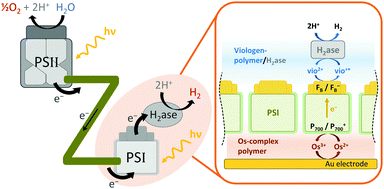A photosystem I monolayer with anisotropic electron flow enables Z-scheme like photosynthetic water splitting†
Abstract
Photosynthetic protein complexes are attractive building blocks for the fabrication of semi-artificial energy conversion devices. However, limitations in the efficiency of the implemented biophotovoltaic systems prevent their use in practical applications. In particular, the effective minimization of recombination processes in photosystem I (PSI) modified bioelectrodes is crucial for enabling a unidirectional electron flow allowing the true potential of the large charge separation at PSI being exploited. Here, we present controlled immobilization of PSI monolayers with a predefined preferential orientation that translates into anisotropic electron flow upon irradiation. Further interface of the oriented PSI monolayer with redox polymers allows an efficient electron transfer and minimization of possible short-circuiting pathways. To complete the functional biophotocathode, the PSI monolayer is coupled to a hydrogenase (H2ase) to realize light-induced H2 evolution. The PSI/H2ase biocathode is then combined with a redox polymer/photosystem II-based bioanode demonstrating a fully light-driven Z-scheme mimic biophotovoltaic cell for bias-free water splitting.



 Please wait while we load your content...
Please wait while we load your content...